Guitar World Verdict
The SG1820 and SA2200 are proof-positive of Yamaha's exacting standards for craft. The SG1820 is big boned but great to play, with a big neck and reassuring weight leaning into its LP-style voice, while the SA2200 is an exercise in refinement and ES-style versatility that is a joy to play.
Pros
- +
Feel and playability off the charts.
- +
Both are tone machines.
- +
Quality builds and finishes.
- +
Great value, especially the SA2200.
Cons
- -
Limited colour choice and no left-hand options.
- -
SA2200 might be a bit too posh for some.
You can trust Guitar World
The giant Yamaha Corporation was once likened to a vast ocean tanker to this writer: it moves slowly and in a very considered fashion, at least as far as its guitars are concerned.
Yet some 54 years after Yamaha entered the electric guitar market its reputation for consummate quality and consistency remains – across price points, from beginner to professional. It’s hard to remember playing a ‘bad’ Yamaha guitar, if indeed we ever have.
Most recently, of course, it’s been the Revstar range that has revived interest. This mainly Indonesian-made range didn’t change the guitar world, but it’s probably one of the best examples of a ‘sleeper’ range we can think of.
Only recently, our editor-in-chief Jamie Dickson purchased a 502T, and hasn’t got a bad word to say about it, even though it’s now four years since we wrote about its launch. It’s part of the Yamaha style: if it’s worth doing, it’s worth doing properly. Flash in the pan they ain’t.
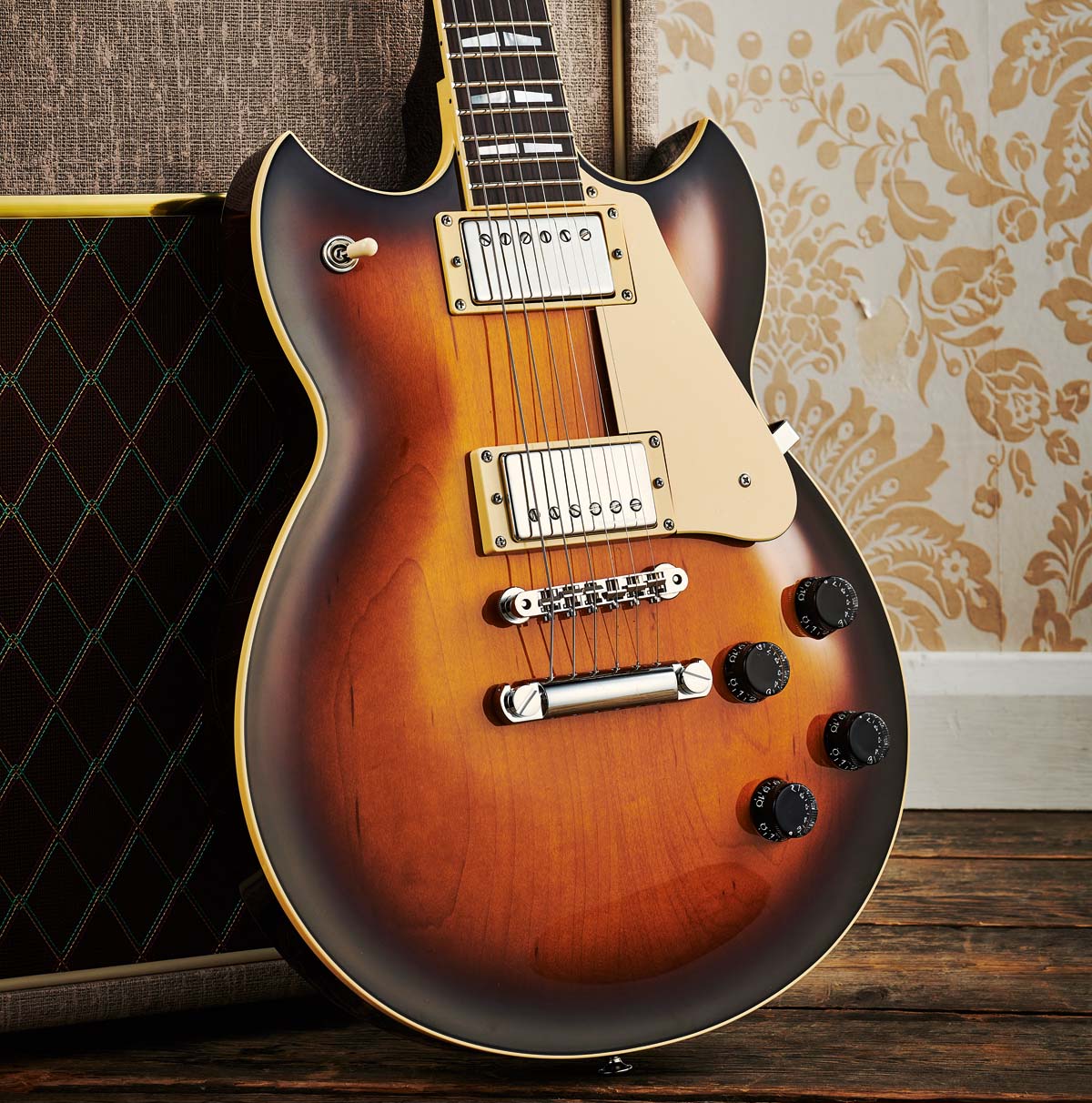
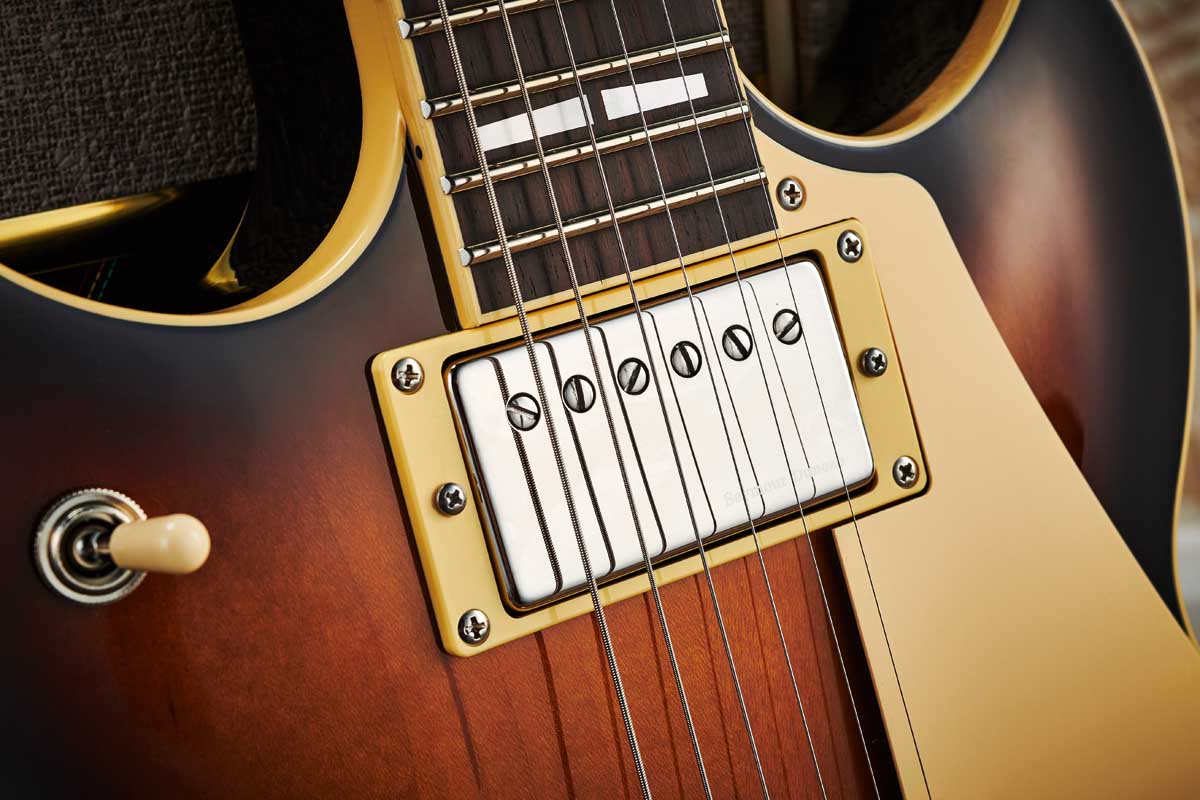
SG1820
The idea for this review started with a simple question: whatever happened to the Yamaha SG? Well, the latest – and only – SGs left in the Yamaha range are a trio of 1800 models launched back in 2010.
They’re pretty much identical guitars save for a few cosmetic details and their pickups: the 1802 features Seymour Duncan single-coil soapbars; the 1820A features EMGs; and the 1820 here (probably the most mainstream) comes with industry standard Seymour Duncan ’59s.
The huge-sounding SG1820 ‘single‑cut’ would easily warrant retrofitting more boutique-style pickups
Colours are limited and very classic, too. By design, these are pro-aimed with pretty much zero of the design innovations or idiosyncrasies of that groundbreaking SG2000. If that original SG was intended to be a better and different-sounding Gibson Les Paul, the 1820 is, well, a Les Paul with a different shape, and despite its symmetrical doublecutaway outline, it sounds like one without question.
In terms of outline, the SG follows the lower body of the Les Paul very closely: its waist is slightly lower and wider across the body, while those horns flare out a little adding to the slightly chunkier look. The cutaway of the treble horn mirrors that of the Les Paul and the heel sits a little lower.
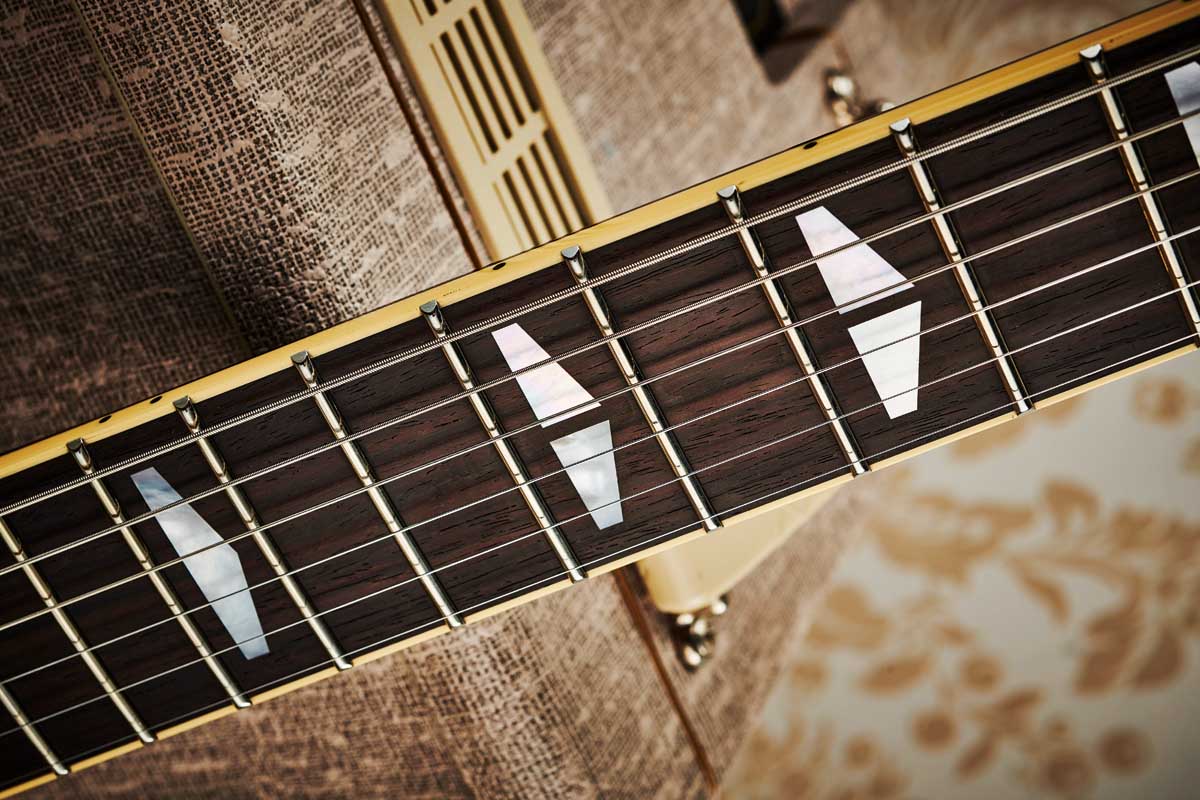
This could be an advantage for the SG, except that the upper strap button mounts behind the heel (like a Gibson SG or ES-335) and, depending on what strap you attach, can certainly impede your upper fretting.
It also slightly alters the strapped-on hang of the SG, meaning it tends to tip forward, again like a Gibson SG or ES-335, or indeed the SA2200. The headstock is a little shorter and squarer compared with a Les Paul, and the back-angle is slightly flatter.
More than a few modern guitars don’t last five years in production, let alone a decade without change. But our new sample, whose serial number says it was made in November 2019, is identical to our reference 1820, which was made a decade ago in January 2010.
Consistent? Colour aside, it’s hard to tell the two guitars apart. The construction of the 1800 SG differs in numerous ways to that original SG2000. It features a flat back to the three-piece African mahogany body – intended to maximise the Les Paul-like chunk.
The neck is three-piece, too, although with only one translucent colour you might not notice that detail. On investigating our sunburst example, though, the centre section appears to be quartered, and you can also see that the maple cap clearly drops into the ‘plain top’ grade.
With a rim depth of pretty much bang on 50mm and overall depth of 60mm, there’s no weight relief or chambering – and it’s little surprise that the guitar is no lightweight at 4.41kg (9.7lb), just a little heavier than our 10-year-old reference, which weighs in at 4.14kg (9.1lb). Part of the 1800 concept back in 2010 was to use up-to-the-minute hardware that was fit for performance purpose.
So the TonePros tune-o-matic and stud tailpiece are firmly locked to their posts, the Grover tuners are locking, and the nut is Graph Tech Tusq. But this is now the sort of kit you’ll see on guitars a third of this price, a bit like the almost generic Duncan ’59s. Then there’s the gloss polyurethane finish, which you won’t find on a Gibson or PRS.
However, it’s very thin – it’s sunken into the grain a little on our decade-old example. There’s also a final important and proprietary twist in the form of Initial Response Acceleration (IRA; see the Vibrating Wood box over the page), which features on both our review models.
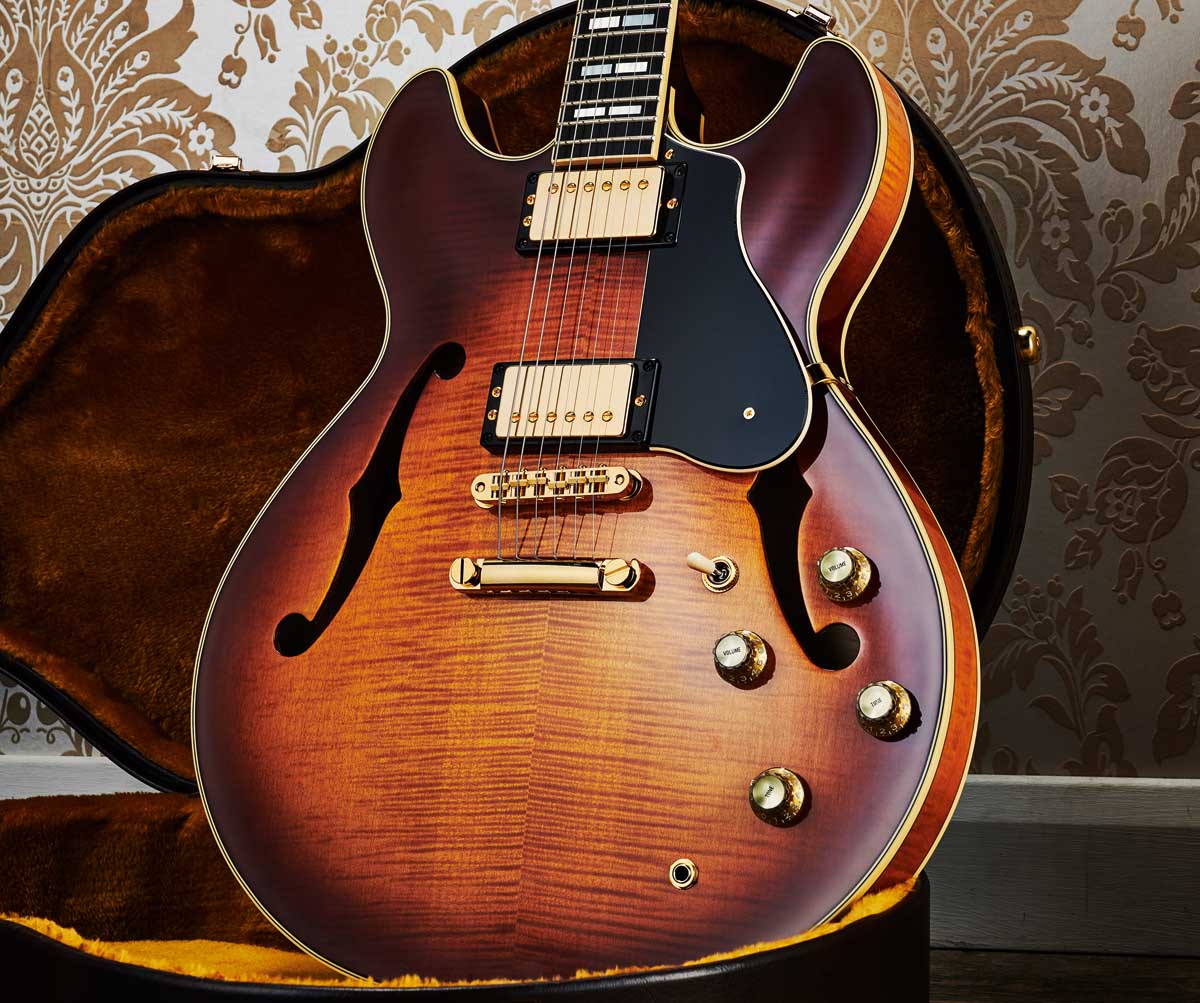
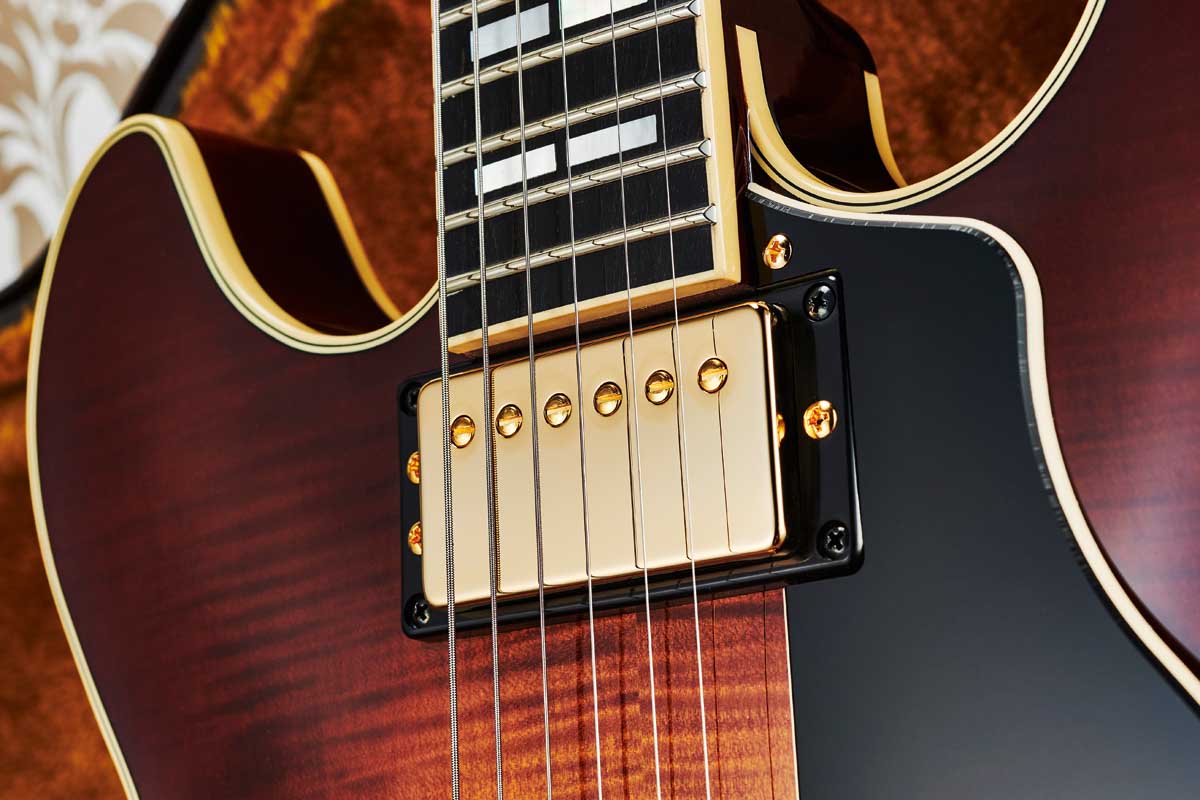
SA2200
With its resplendent gold-plated hardware and lightly flamed laminate facings, our SA2200 (which was made in May 2020) is the sort of guitar that should come with a tuxedo. Its inspiration is obvious and there’s no downsizing here. No, this is a pretty straight 16-inch-wide thinline with a soft maple centre block and five-ply maple-faced laminate construction. For the record, the Yamaha USA website says it’s sycamore.
It’s immaculately turned out, of course, from the careful craft of the super-tidy inside with its kerfed mahogany linings to the great binding with inner purfling lines that drop just to a single-ply cream for the fingerboard. It’s even jazzier around the headstock, which, at around 180mm long by 85mm at its widest point, is slightly bigger than the 166mm by 78mm dimension of the SG’s. It’s also slightly flatter in terms of its back angle than the SG.
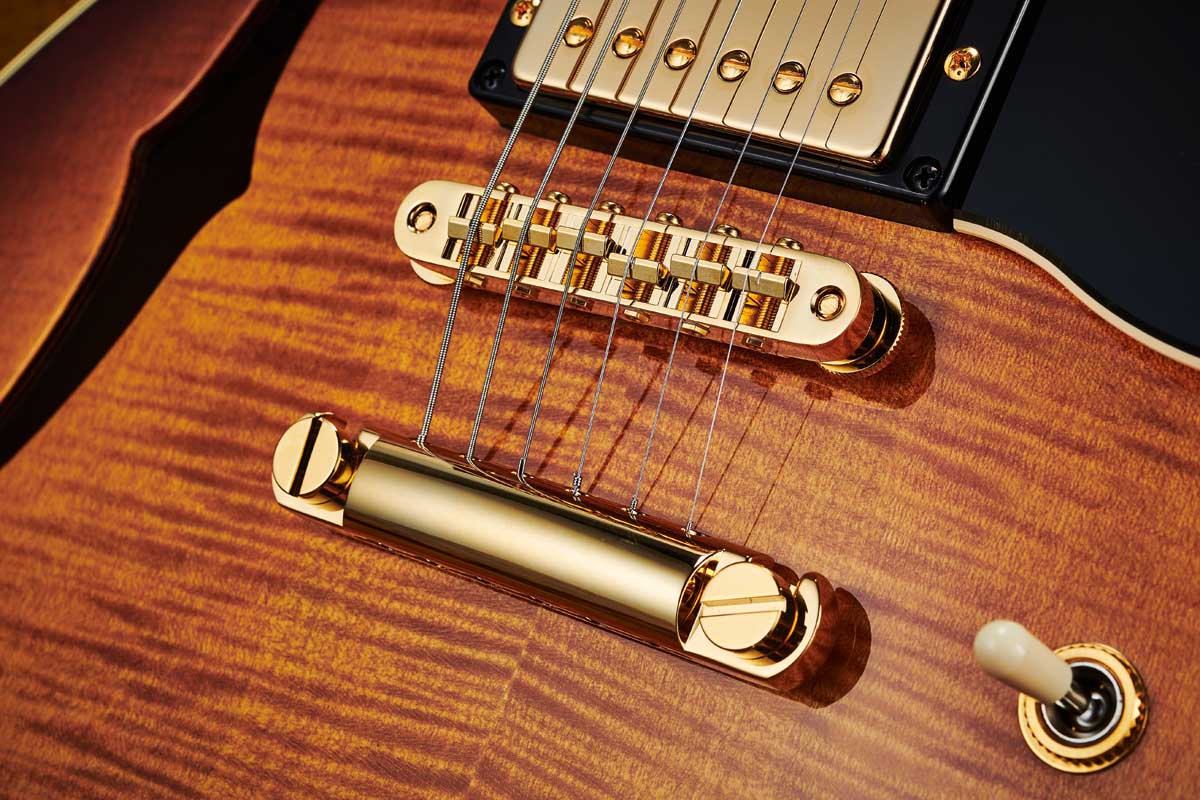
The body rise seems slighter than the classic it’s imitating and, as you can see, the dual horns are thinned, a style we’ve seen on many Japanese and other reruns of this classic. Like the SG, the finish is quoted as gloss polyurethane, but again it appears extremely thin and beautifully applied.
This attention to detail is everywhere: from obvious things like fretting on the ebony fingerboard with its bright, vibrant inlays and the superbly cut bone nut, to more subtle details such as the rounding of the bound fingerboard edge and the perfect shaping of the traditional heel.
Unlike the SG1820, the SA2200 sticks with homegrown Gotoh hardware that no one is going to turn their nose up at, and the pickups are simply Yamaha Alnico V, which are actually slightly hotter that those ’59s going on measured DCRs.
Here, we also get coil-splits on the tone controls – pull-push switches not push-push types, which we’ve seen on previous Yamahas.
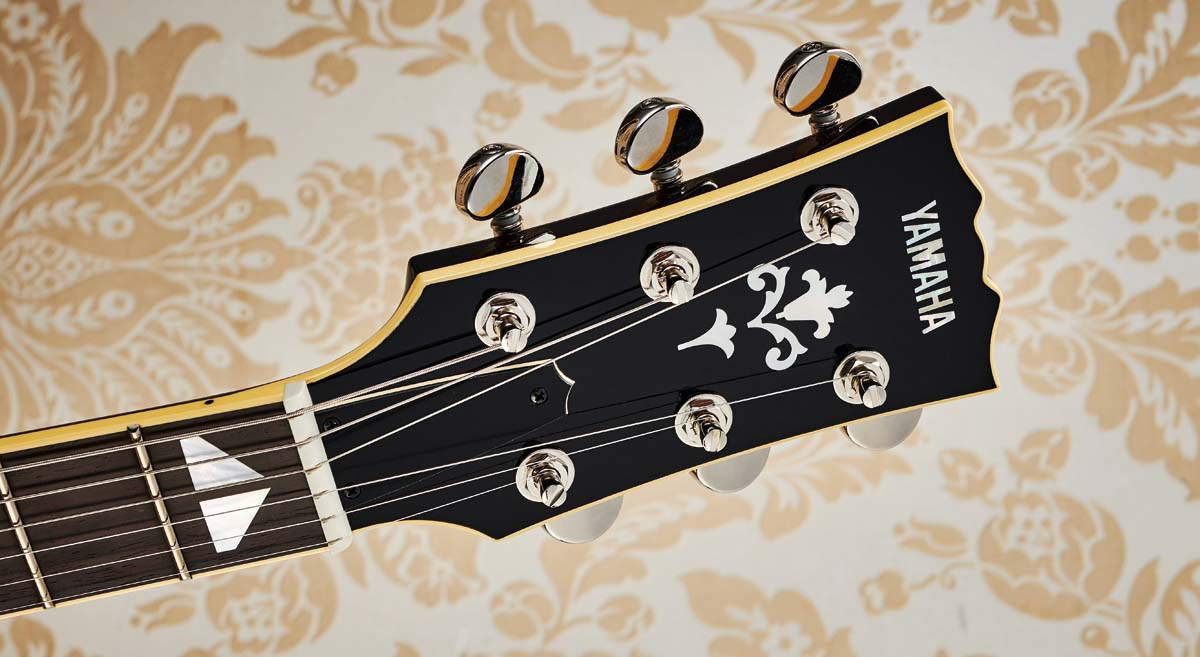
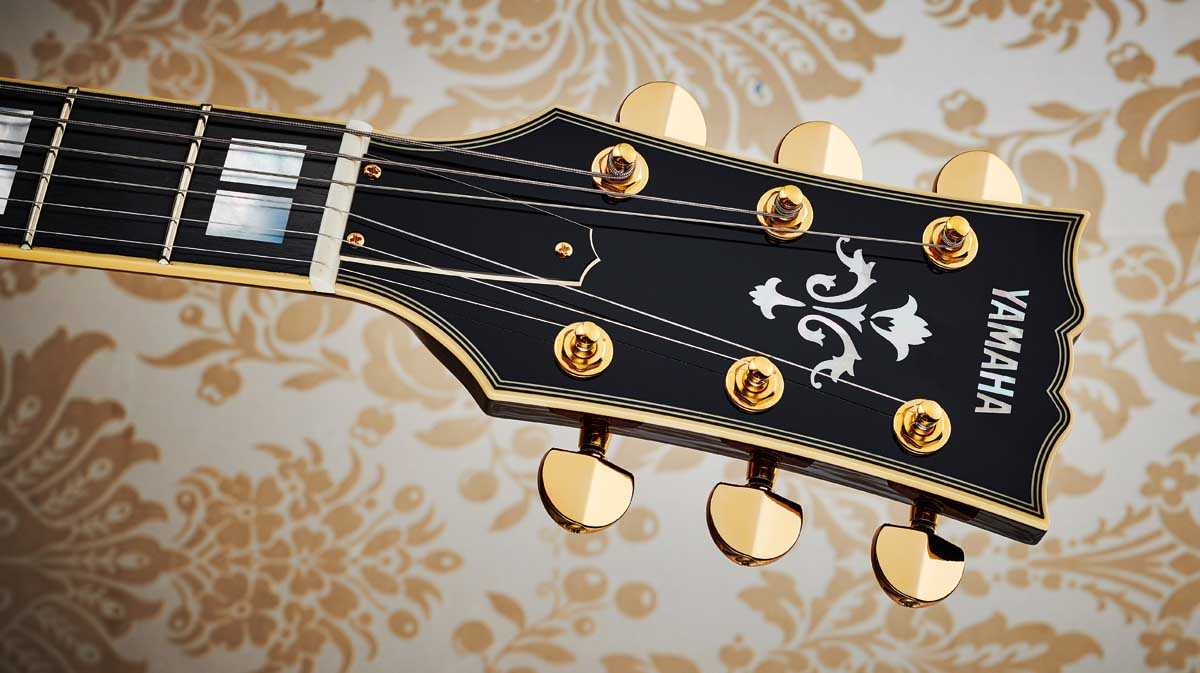
Feel & Sounds
These 1800 series SGs might have changed to a more conventional construction, but this 1820 still comes across as a big grown-up guitar from its overall weight, that body girth and a neck that most of us would call big.
Dimensionally, it’s virtually identical – and clearly an influence on – the more contemporary Revstars: approximately 21.4mm at the 1st fret filling out to 25.4mm by the 12th with a slightly wider nut width of 43.7mm and virtually identical at the 12th fret at 53mm. It’s certainly a full C profile, the rounded shoulders actually making it feel bigger than it is.
Our reference 1820 is in Vintage White and we’d swear the neck is bigger than the Sunburst model we have on review, though in reality it isn’t – not the first time colour is playing a trick on our hand.
The SA2200 is very similar width-wise with a similar 1st fret depth but a more manageable depth as the neck progresses, at 23.5mm by the 12th. The shoulders feel slightly more relaxed, too.
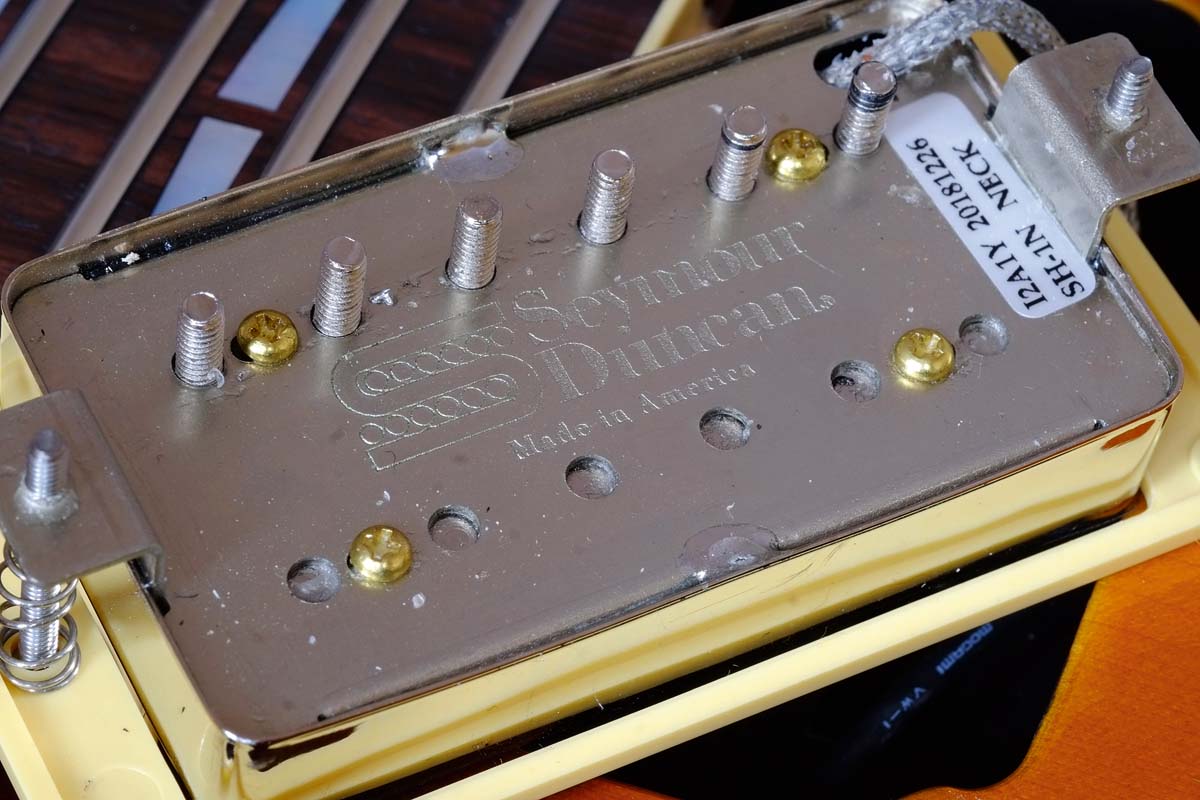
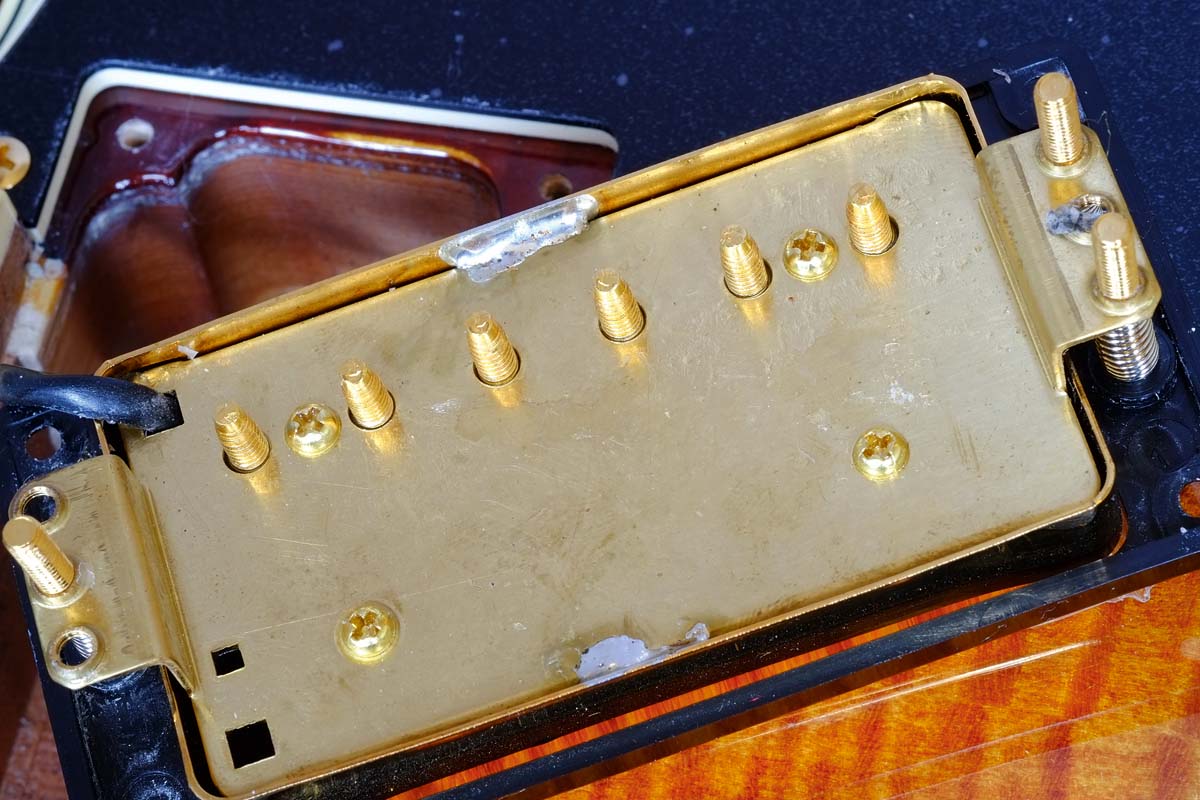
The other thing is that, much like a Gibson SG – or any other guitar with a top strap button behind the heel – the feel of the guitar when strapped on does take a little adjustment if you’re used to the more conventional button placement on the top horn.
The body does tip forward more. It’s a more ‘extreme’ experience than playing a contemporary Revstar, but it shares some family traits, not least its relatively big neck.
Artificial ageing, the conditioning of wood, is pretty much as dark as this art gets. It is impossible to evaluate what effect Yamaha’s IRA is having as the end user: we simply don’t have an identical guitar that’s untreated to compare it to. But listening to the new SG and comparing it to our own 10-year-old model and our usual single-cut references, it’s a very good example of the style, the recipe.
The SA2200? It’s a deliciously regal voice played clean with slightly more air to the sound and a deft balance of smoothness with clarity. Yes, it might look like the sort of thing you’d play cocktail jazz on – which you certainly can, of course – but show it a pretty cranked amp and it really displays its rock credentials, slipping into musical feedback with just a lean towards your amp.

Okay, you say, that’s what a ES-335 does. And let’s not pretend otherwise; this is someone else’s design. But it’s such a well-made, carefully considered piece that the guitar just disappears while we spend far too much time playing it. It’s one of those ‘desert island’ guitars, for sure.
Yet it’s also a superbly complex voice that effortlessly morphs from rich velveteen jazz and juicy fusion through to also Fender-y quack from the coil-splits, which voice the inner slug coils of both and are where the mix and the neck pickup excel.
Whatever is going on under the hood here is also considered: the tone control taper and cap values make both tones, in both modes, hugely reactive. If there’s a bad sound on this guitar, we didn’t find it. It’s one of the best-sounding and most versatile guitars of its style we’ve had the pleasure to play.

Verdict
If you need proof that Yamaha can build world-class guitars, look no further than this pair. They are handmade, artisan style, in small numbers at a relatively small workshop in Japan, which crafts all the high-end Yamaha electrics, acoustics and basses.
Our SG1820 is one of only a 100 exclusive models to the UK, and who knows when we’ll get more. In truth, we’re told that the facility simply cannot make enough guitars to satisfy worldwide demand, hence their exclusivity.
Their build style is at odds with the name of the facility, though – Yamaha Music Manufacturing Japan Corporation – and is just one example of the oddities involved here. And then there’s the price: Yamaha’s official SRP prices both instruments out of the market, which is why we’ve used the UK on-sale price here, which is approximately 35 per cent lower.
If you need proof that Yamaha can build world-class guitars, look no further than this handmade, artisan-style pair
The now 10-year-old SG1820, then, is a guitar full of style and history that slots in price-wise under Gibson’s production Les Paul Standard. And although its specification is a little more generic, it’s a beautifully made, huge-sounding ‘single-cut’ as is, and would easily warrant retrofitting more boutique-style pickups and appointments if that’s your thing.
The SA2200, virtually unchanged since it was introduced late in 1991, is probably one of the best kept secrets out there and, again, at the selling price is laughably good value. Its tuxedo style might not appeal to everyone, but its sounds and feel are simply superb: a very professional-level workhorse guitar that really should be on the radar of any serious player.

Specs
Yamaha SG1820
- PRICE: £1,999 (inc case)
- ORIGIN: Japan
- TYPE: Double-cutaway solidbody electric
- BODY: 3-piece African mahogany with maple top
- NECK: 3-piece mahogany, glued-in
- SCALE LENGTH: 629mm (24.75”)
- NUT/WIDTH: Graph Tech Tusq/43.8mm
- FINGERBOARD: Rosewood arrow pearloid inlays, 350mm (13.75”) radius
- FRETS: 22, medium jumbo
- HARDWARE: Nickel-plated TonePros AVRII tune-o-matic-style bridge and T1Z stud tailpiece, locking Grover tuners
- STRING SPACING, BRIDGE: 50.5mm
- ELECTRICS: Nickel-covered Seymour Duncan ’59 humbuckers, 3-way toggle pickup selector switch, individual volume and tone controls, 3-way toggle pickup selector switch
- WEIGHT (kg/lb): 4.14/9.1
- OPTIONS: None
- RANGE OPTIONS: The SG1802 features Seymour Duncan P-90 soapbars; the 1820A comes with an active EMG 81/85 pickup set
- LEFT-HANDERS: No
- FINISHES: Brown Sunburst (as reviewed) Black, Vintage White – gloss polyurethane
Yamaha SA2200
- PRICE: $1,999 / £1,699 (inc case)
- ORIGIN: Japan
- TYPE: Double-cutaway thinline electric
- BODY: Laminated 5-ply figured sycamore with soft maple centre block
- NECK: Mahogany, glued-in
- SCALE LENGTH: 629mm (24.75”)
- NUT/WIDTH: Bone/43.3mm
- FINGERBOARD: Ebony, split rectangle mother-of-pearl inlays, 350mm (13.75”) radius
- FRETS: 22, medium jumbo
- HARDWARE: Gold-plated Gotoh GE103B Nashville-style bridge and GE101Z stud tailpiece, Gotoh SG30 tuners
- STRING SPACING, BRIDGE: 52mm
- ELECTRICS: Gold-plated covered Yamaha Alnico V humbuckers, individual pickup volume and tone controls (with pull-push Bi-Sound coil-split)
- WEIGHT (kg/lb): 3.79/8.34
- OPTIONS: No
- RANGE OPTIONS: None
- LEFT-HANDERS: No
- FINISHES: Violin Sunburst (as reviewed), Brown Sunburst – gloss polyurethane
- CONTACT: Yamaha

Dave Burrluck is one of the world’s most experienced guitar journalists, who started writing back in the '80s for International Musician and Recording World, co-founded The Guitar Magazine and has been the Gear Reviews Editor of Guitarist magazine for the past two decades. Along the way, Dave has been the sole author of The PRS Guitar Book and The Player's Guide to Guitar Maintenance as well as contributing to numerous other books on the electric guitar. Dave is an active gigging and recording musician and still finds time to make, repair and mod guitars, not least for Guitarist’s The Mod Squad.
“This would make for the perfect first guitar for any style of player whether they’re trying to imitate John Mayer or John Petrucci”: Mooer MSC10 Pro review
“The most in-demand mods straight from the factory”: Fender’s elevated Player II Modified line brings the firm’s most sought-after guitar upgrades to the masses












